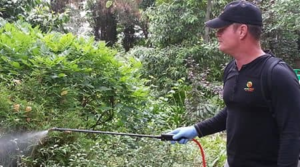Pezz Pest Control involves methods to prevent pests from damaging plants, crops or animals and their by-products. Physical controls include traps, netting, screening, barriers, and radiation.

Monitoring pest numbers often includes scouting. Pheromones are used in some traps to attract and confuse male insects, reducing pest numbers.
Some varieties of plants, wood and animals are resistant to specific pests. Resistant species arc less likely to be damaged by pesticides.
Accurate pest identification is the first step in developing a successful pest control program. Identification will provide information on such things as the pest’s food, environmental and harborage needs, life cycle and when it is most vulnerable to being controlled. Incorrect pest identification can lead to the use of inappropriate management tactics. It is important to note that many pest species look different at various stages of their lives and when they are in certain habitats. This can make it difficult to identify them visually.
Observing the behavior of the pest can also help to make an accurate identification. For example, a pest’s feeding habits, nesting preferences and activity patterns can all be used as clues to help determine the species infesting a property. This can be especially helpful when examining the results of pest damage to plants and other resources.
It is important to note that the pest identification process can be a tricky one, particularly when dealing with invasive pests. Many of these pests can be incredibly resilient and may even be resistant to some commonly used controls. For this reason, it is always best to work with a professional when trying to identify pests and their behaviors.
Having an effective pest control strategy can protect against the damaging effects of invasive insects and other harmful organisms. While a variety of strategies can be used to manage pests, the method that is chosen will depend on the type and severity of infestation. It is important to consider the benefits and risks of each option and to follow local, State and Federal regulations when applying any pest control methods.
When choosing a pest control service, it is important to shop around and get recommendations from friends and neighbors. Once a pest control company has been selected, it is important to thoroughly examine their treatment plan, cost and warranties. Obtaining an estimate from several companies will give you a better idea of the average price for this service. It is also a good idea to check the company’s licensing and certifications before hiring them.
Pesticides
A pesticide is any substance or mixture of substances used to prevent, destroy or repel a pest. Pesticides can be found in many forms including liquids, powders and gels. Most people think of insecticides, herbicides and fungicides when they hear the word pesticide but pesticides can also include mosquito sprays, ant baits, sulfur dust in the garden, pet flea collars, and disinfectant wipes. Whenever you use pesticides, be sure to read the label instructions carefully (especially the safety instructions) and use the least amount possible. Always wear the protective equipment that is suggested in the label instructions and seek urgent medical attention if you suspect pesticide poisoning.
All pesticides have the potential to affect non-target plants and wildlife, even if they don’t kill them. The most common way this happens is through “drift,” which means that some of the applied pesticide lands on or near non-target vegetation. Some pesticides can also “leach” into the soil, contaminating waterways and other areas. For example, according to the US Geological Survey, 21 of the most commonly used herbicides and insecticides—including 2,4-D, diuron and prometon—have been detected in urban streams.
Indirect effects can also be caused by pesticides, including reducing biodiversity and killing natural enemies of crop pests. These effects are harder to measure than direct impacts because they occur in the wider environment and depend on ecological mechanisms.
The toxicity of a pesticide depends on how much is exposed, the duration of exposure, and the body’s ability to eliminate it. Toxicity can also vary by how soluble the chemical is, the form it’s in, and the way the body absorbs or ingests it. For example, liquids may be more absorbed by the skin than powders.
In addition, some pesticides are “systemic” and move (translocate) inside the plant. This allows them to reach a higher level of the plant where they can have their most damaging effect. Other pesticides are “contact” pesticides, which remain on the surface of the plant and act directly through contact with the pest. These are usually more toxic than systemic pesticides.
Treatment Methods
A pest control method can be any action taken to remove or prevent the growth of harmful organisms. Generally, it involves altering the environment to limit the growth of pests or using physical barriers to stop them from entering buildings or crops.
Physical barriers include traps and netting to stop rodents or insects from accessing areas they aren’t supposed to be in. Poison bait is another popular and effective pest control strategy. It comes in the form of granules, gels or liquids, and is spread around the area where pests have been seen. When consumed, the pesticides target the pest’s nervous system, metabolism or reproduction, killing them or stopping them from reproducing. This method of pest control is usually used in combination with other methods, such as sealing cracks and gaps in walls and foundations.
Biological pest control uses natural predators or parasites to reduce the number of unwanted organisms. This is an environmentally friendly option that doesn’t require harsh chemicals. However, it can be a time-consuming process and may only have limited effect on larger infestations of some pests.
Chemical pesticides are a reliable way to get rid of stubborn pests. They can be found in a wide range of forms, including repellents and insecticides. Many of these solutions are formulated to kill or repel specific pests, and they often work faster than physical methods. However, if the incorrect solution is used it can damage plants and cause harm to people.
Fogging pest control is an alternative to insecticides that can be used against adult flying pests, such as mosquitoes, flies and moths. It uses a machine that blows a mist of a pesticide over the infested area. This type of pest control is considered environmentally friendly and odourless, and doesn’t leave any residues that can be difficult to clean.
Cultural pest control involves changing the environment to prevent pests from growing or spreading. This method can be a good option for farms, as it helps prevent the need to use chemical pesticides on crops and allows farmers to protect their soil quality. Examples of cultural pest control include crop rotation, planting resistant varieties and adjusting irrigation practices. Another preventative approach is pest insulation, which uses materials like borate-treated cellulose to create an unattractive barrier for pests.
Prevention
The goal of pest control is to keep pest numbers below an acceptable level without causing unnecessary harm to people, property or the environment. This is accomplished by implementing a strategy that includes prevention, suppression and eradication. Prevention methods involve examining the environment to see what is attracting the pests, and then using this information to create an inhospitable home or work place. For example, keeping the areas around buildings free of clutter can prevent pests from entering through small cracks and crevices. Maintaining good hygiene also deters many pests, as can sealing food in containers and securing trash bins.
In addition, natural predators and parasites can reduce pest populations by eating the pests or competing with them for resources. Climate can affect the growth of plants, and thereby influence the number of pests that feed on them. Pests that live near water sources are often affected by floods and droughts.
Natural barriers, such as soil type and physical barriers, can sometimes stop pests from moving into or out of a site. For example, earthworms help improve soil quality, and thus limit the number of pests that can feed on it. Other natural forces that can help or hinder pest control include rainfall, day length and temperature.
Chemicals are often used in pest control, but this should be done with care to minimize environmental impact. It is important to always read the label of any chemicals being used and follow the instructions precisely. This helps minimize the chance of poisoning or other hazards to people and pets.
The most effective method of reducing the use of pesticides is to use non-chemical control tactics, such as baits and traps. These should be set carefully so that they are not accessible to children and pets. If a pesticide must be used, it should only be applied as directed. This reduces the amount of toxic chemicals that are released into the air and can reach people, pets or plants.
Other non-chemical control measures include sanitation and habitat modification. These can help to reduce the number of pests that move into a site. Cleaning up rubbish can also help, and removing places where pests like to hide, such as under bushes or in piles of wood, can make the area less attractive.
